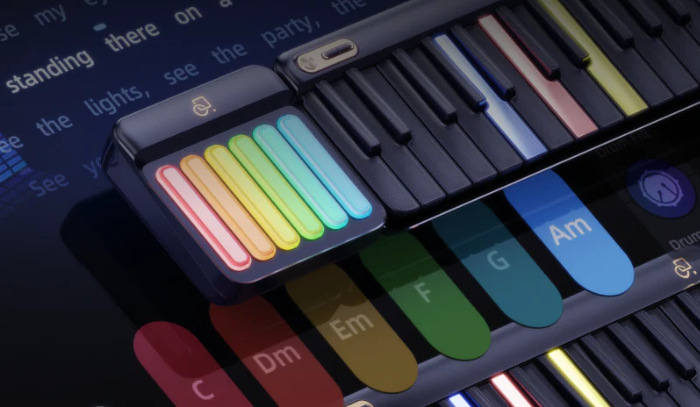
If you’ve ever picked up a guitar or thought about learning you've probably asked:
“How many strings does a guitar have?”
At first glance, the answer seems simple. Most people know the standard guitar has six strings. But as you explore different styles and formats, acoustic, electric, bass, even smart guitars you'll quickly find that string counts can vary depending on the type of instrument and the player’s goals.
The classic 6-string setup used by most beginners
Extended-range guitars like 7, 8, and 12-string models
How smart, tech-enhanced guitars are helping people learn faster than ever
Whether you're a total beginner, a curious parent, or shopping for your first instrument, this article will help you understand the role strings play and how modern options make getting started with guitar easier and more fun than ever.
The vast majority of guitars whether acoustic, electric, or even modern smart guitars come equipped with six strings. This configuration has become the global standard because it offers the perfect balance of simplicity, range, and playability.
From lowest to highest pitch, the standard tuning for a 6-string guitar is:
E – A – D – G – B – E
This setup allows players to play a wide variety of chords, melodies, and scales across genres like rock, pop, classical, jazz, and blues. It’s also the tuning most commonly used in guitar tutorials, music books, and learning apps.
Accessible for beginners: Enough range to learn songs and play full chords without being overwhelming
Musically versatile: Covers bass notes, middle harmonies, and high melodies
Standard across guitar stores: Whether you’re buying online or in person, most beginner models follow the 6-string format
For anyone just starting their musical journey, a 6-string instrument is the best entry point; it's what you’ll find in most homes, classrooms, and instructional programs.
While the six-string guitar is the most common, it's far from the only option available. As players progress or explore different genres they often encounter guitars with more (or sometimes fewer) strings. These instruments offer extended range, unique textures, or specialized purposes.
Here’s a breakdown of the most popular variations you might come across in any well-stocked guitar store or online shop.
Adds a low B string below the standard low E
Common in metal, rock, and jazz for deeper tones and heavier riffs
Offers extended range without dramatically changing chord shapes
Not typically recommended for complete beginners, but exciting for advancing players
Includes both a low B and high A string
Used in experimental music, progressive rock, and some modern metal
Provides access to bass-style low notes and extended high-register melody work
Requires advanced finger strength and a good understanding of fretboard layout
Doubles each of the 6 standard strings (in octaves or unison)
Produces a richer, fuller sound with a natural chorus effect
Often used in folk, rock ballads, and studio recordings
More tension on the neck, harder to press strings better suited for intermediate players
Bass guitars usually have 4 or 5 strings and serve a different role entirely
Smart guitars typically keep the standard 6-string layout for accessibility
Instruments like baritone guitars or fretless models also exist, but they cater to niche playing styles and advanced users
As technology continues to reshape how we learn and play music, smart guitars are quickly becoming one of the most exciting tools for beginners and casual players alike. But what exactly is a smart guitar and how does it compare to traditional models?
A smart guitar is a modern instrument that combines the structure of a traditional 6-string guitar with built-in technology designed to assist with learning and performance. These features often include:
LED lights embedded in the fretboard to show finger positions in real time
Bluetooth connectivity to sync with learning apps
Gamified tutorials that teach chords, scales, and full songs step by step
Audio feedback and progress tracking to help users improve over time
Unlike extended-range instruments that require advanced skill, most smart guitars stick with the familiar 6-string layout making them ideal for beginners and families.
Smart guitars are bridging the gap between music education and tech-enhanced interactivity. They’re especially popular with:
First-time players who want to learn songs quickly
Parents looking for an engaging way to introduce music at home
Adults returning to guitar after a long break
Anyone who learns best visually or through hands-on practice
By showing exactly where to place your fingers and guiding you through songs, these instruments eliminate the guesswork that holds many learners back.
Smart guitars still need to be tuned, strung, and handled like regular guitars. They use standard strings, offer full playability unplugged, and connect to mobile apps for added support. You can find many of these models at your local guitar store or through specialized online retailers.
Whether you’re using a traditional acoustic, an electric model, or even a smart guitar, knowing how to string it properly is an essential skill. While it may seem intimidating at first, restringing a guitar is something every guitarist should feel confident doing and once you’ve done it a couple of times, it becomes second nature.
A new set of guitar strings (make sure they’re the right type for your instrument)
String winder (optional but helpful)
Wire cutters or string snips
A tuner (manual or app-based)
Loosen and remove old strings: Use the tuning pegs to slacken each string, then unwind them from the pegs and remove them from the bridge.
Clean the fretboard (optional but recommended): Take this opportunity to wipe down your fretboard especially if it's been a while since your last string change.
Insert new string through bridge: Depending on your guitar type, the string may thread through the bridge or the body. Pull it through until secure.
Pull string through tuning peg: Thread the string through the peg hole, leaving a bit of slack for winding.
Tighten and wind the string: Begin turning the tuning peg while guiding the string so it coils neatly downward on the post. A string winder speeds this up.
Repeat for all six strings: Move from low E to high E or vice versa until all strings are replaced.
Stretch and tune: Gently stretch each string and return until they stabilize. New strings need to be tuned a few times before they stay in place.
Change one string at a time to avoid confusing string order or losing tension on the neck
Label the strings (E-A-D-G-B-e) during your first few changes
Many smart guitars come with visual tuning assistance through their companion apps making this process easier to follow
Starting your guitar journey is exciting but choosing your first instrument can feel overwhelming. With so many types, styles, and technologies available, how do you know which guitar is right for you?
Whether you're looking at acoustic, electric, or exploring the world of smart guitars, the key is to find a guitar that matches your learning goals, lifestyle, and comfort level.
No amp needed
Great for learning chords, fingerstyle, and strumming
Simple, no-frills experience
Good choice for traditional learners or casual practice
Pros: portable, timeless sound, easy to find in any guitar store
Cons: can be harder on fingers for some beginners due to higher string tension
Requires an amplifier
Lighter string tension = easier fretting for beginners
Great for learning leads, riffs, and expressive bending
Pros: versatile tones, easier to press strings
Cons: needs additional gear (amp, cables)
Standard 6-string layout + built-in learning tools
Often includes LED fretboard lights, Bluetooth, and app sync
Gamified learning, song libraries, real-time feedback
Great for visual learners or independent practice
Pros: guided experience, beginner-friendly, built-in motivation
Cons: may cost more than basic acoustic, but adds value through learning tools
Playability: Does it feel comfortable in your hands and lap?
Learning support: Do you want built-in tools or prefer a traditional path?
Space & noise: Acoustic is quiet; electric and smart guitars often have headphone options
Budget: Balance upfront cost with long-term value (especially if lessons are included in an app)
Just like traditional guitars, most smart guitars have six strings. They maintain the standard layout (E–A–D–G–B–E) so that learners can transition easily to other guitars later. The "smart" part refers to the built-in technot a different string format.
Yes! Smart guitars are specifically designed to help beginners get started with less frustration. With visual feedback (like LED fretboard guidance) and app-connected tutorials, they remove the guesswork and make learning more intuitive.
Absolutely. Smart guitars use standard guitar strings and follow the same restringing and tuning process. You can refer to beginner stringing tutorials or use your smart guitar’s app for guided assistance.
You’ll need the internet for initial app setup, downloading songs, or syncing updates. But once content is downloaded, many smart guitar features (like LED learning and offline practice modes) work without an active connection.
It depends on your learning style. If you’re a visual or independent learner who prefers tech-enhanced tools, a smart guitar offers a structured, rewarding way to start. Traditional guitars are great too but often require more outside resources or lessons to stay motivated.
While most guitars from acoustic to electric to smartstick to the classic six-string format, the way we learn them is changing fast. For beginners, learning to play guitar is no longer limited to scales, sore fingers, and expensive private lessons.
Whether you're exploring chords on an acoustic or following lights on a smart guitar, today’s technology makes music more accessible, flexible, and fun than ever before.
From understanding string basics to learning how to change them, and choosing the right model to fit your goals, the path to playing your first song is simpler than ever.
Read more

Best Smart Keyboards 2025: PopuMusic vs ROLI
If you're in the market for a piano keyboard in 2025, you're not alone and you're not just choosing between weighted keys or brand names anymore. The newest generation of smart piano brings technol...

Best Cheap Keyboard Piano Picks for Beginners That Don’t Feel Cheap
Starting your piano journey doesn’t have to mean draining your savings. Many beginners/kids, students, and adults alike want to explore music without committing to a big investment up front. The go...